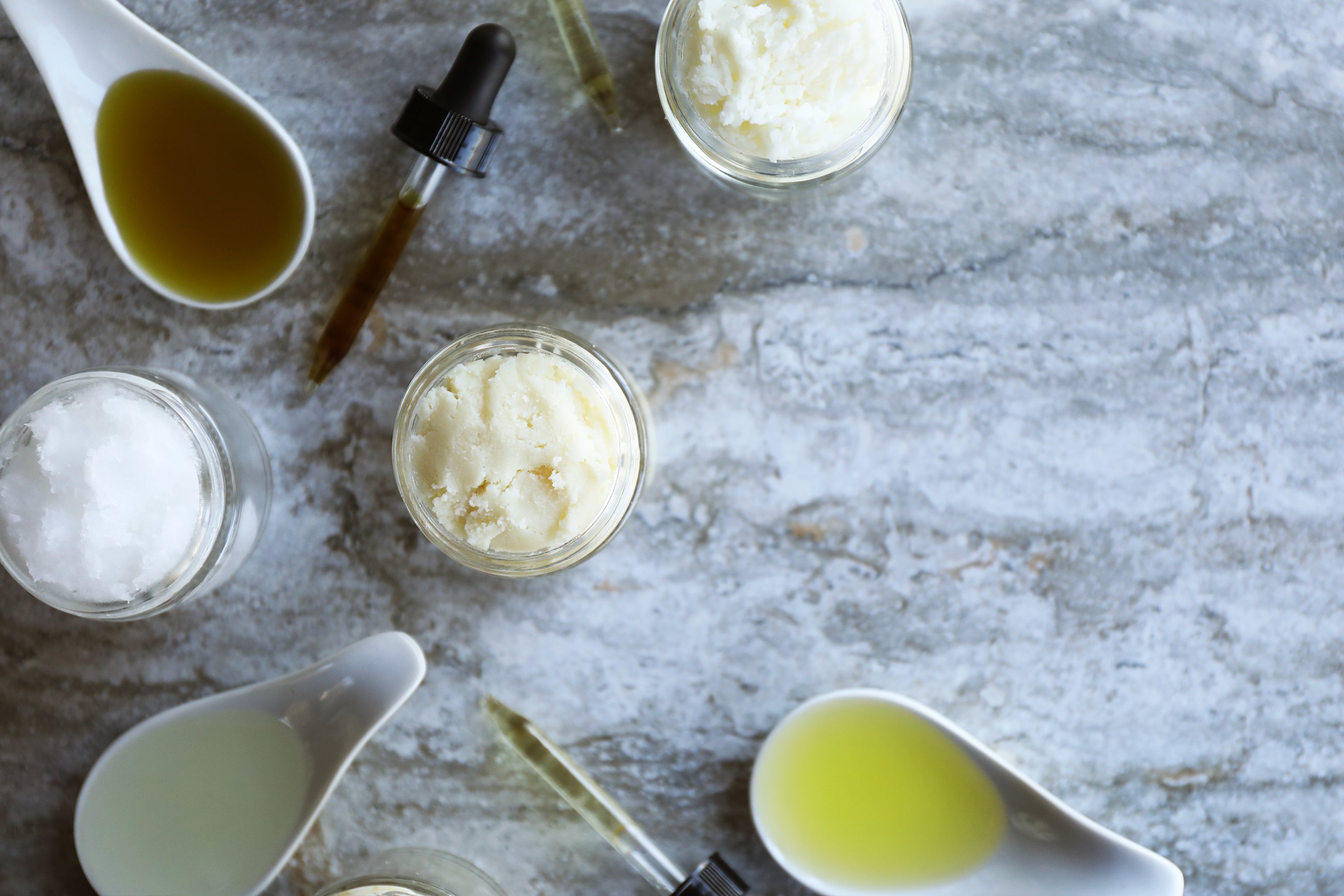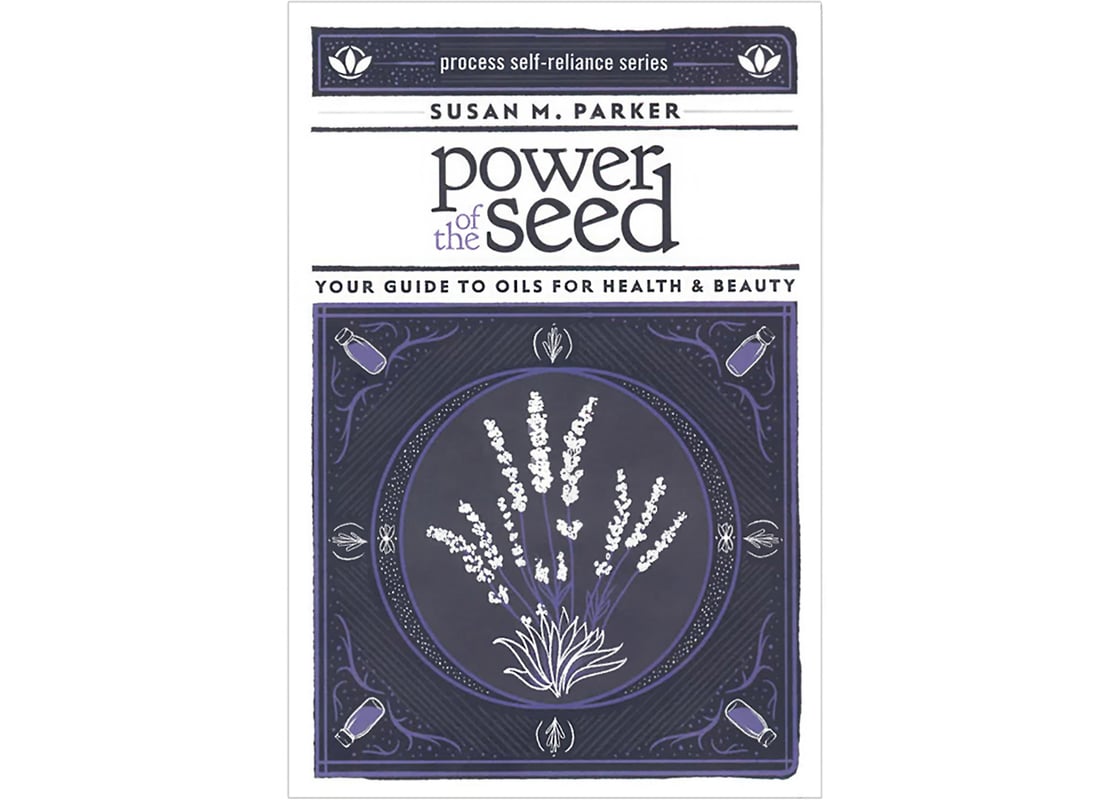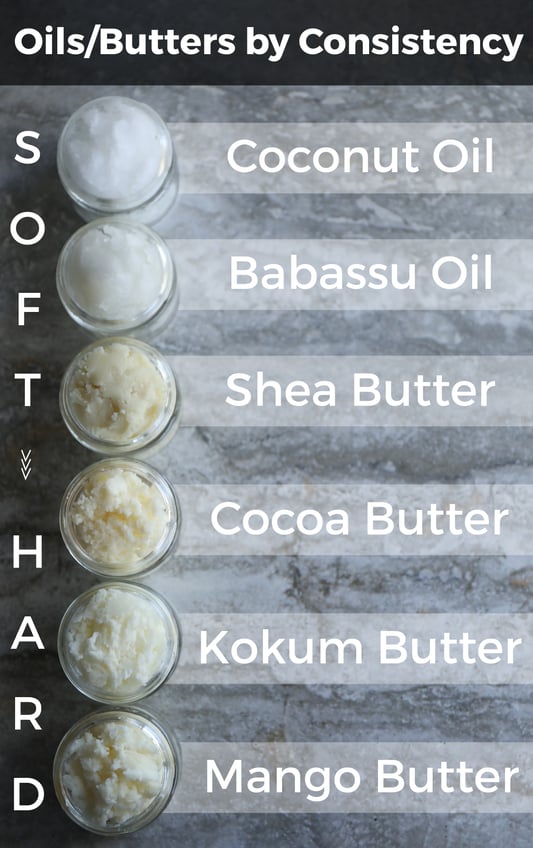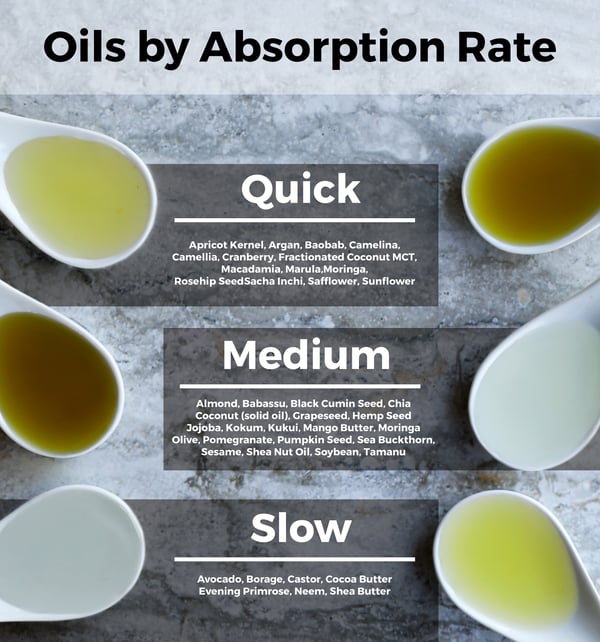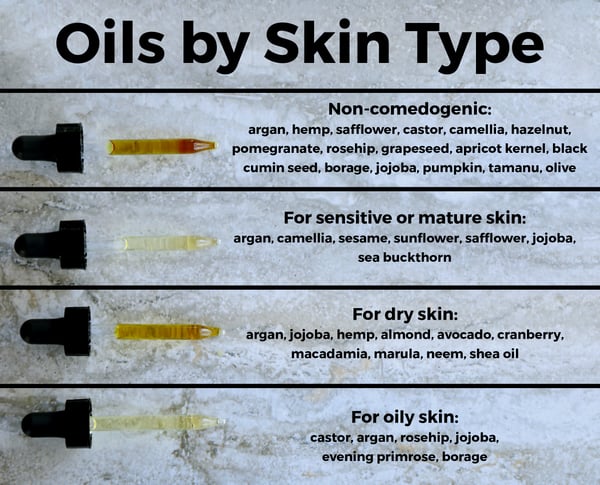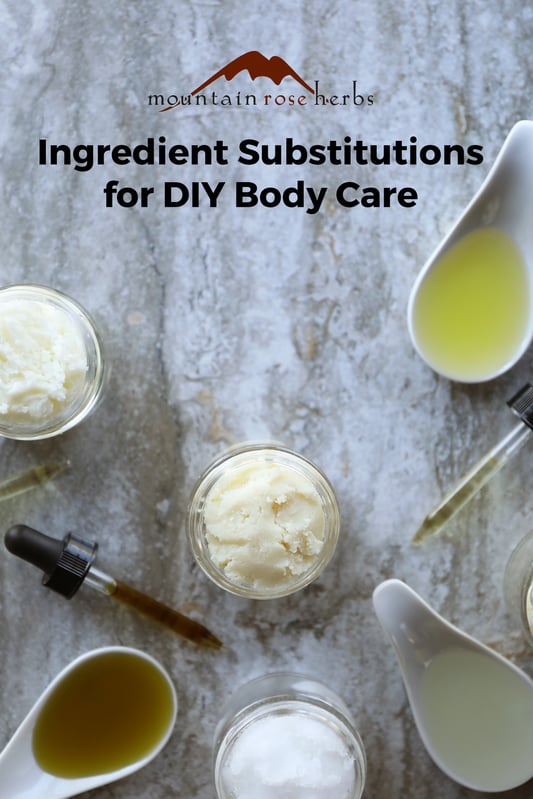There seems to be an endless number of recipes available for body butters, skin oils, and other DIY personal care products. This variety can be inspiring, but also overwhelming at times—after all, there are only so many carrier oils any one person can keep on-hand! Furthermore, since every body is different, it is sometimes necessary to avoid a particular ingredient due to a personal sensitivity, or perhaps just a personal preference (not everyone loves the scent of raw shea butter, and to each their own!). That's why, as an avid recipe tinkerer, I'd like to offer some tips for making appropriate ingredient substitutions to adapt body care recipes to your needs.
There are several factors to consider when swapping out oils, butters, or waxes. Of course, each individual oil or butter contains a unique combination of nutrients and fatty acids, and while these subtle variations are definitely worth exploring, diving into the properties of each of the dozens of carrier oils we offer would involve more information than we can fit in a single blog (I'd recommend checking out the description on each one's product page for specific details, as well as the excellent book Power of the Seed: Your Guide to Oils for Health & Beauty). No one knows your skin better than you, so experimentation is often the best way to become familiar with the ingredients that best meet your needs. That said, there are some general guidelines that may help make your trial-and-error process more efficient.
Breaking Down Basic Substitutions
Each formula is designed to be applied in a certain way and to impart certain benefits—a facial moisturizer is intended to lightly nourish delicate skin without heaviness, whereas a dense body butter may offer a protective layer of lasting hydration to extra-dry areas through humectants, which help to retain and attract moisture from the air (beeswax is a common example). Rather than getting into the weeds about individual ingredients, in this post, we'll focus on making substitutions that preserve the general character and function of your formula overall. To achieve this, we'll focus on three main ingredient characteristics: consistency, absorption rate, and skin type compatibility.
Substituting by Consistency
The first and easiest rule for substituting oils or butters is to match the consistency. You wouldn’t use shea butter in place of apricot kernel oil right? Well, you could, but it would definitely have a noticeable impact on your end result (by, say, turning your solid lip balm into a liquid gloss).
When trading one ingredient for another, make sure it is basically the same in its texture and state at room temperature and when applied to skin. Many oils are liquid at room temperature, so they can be used interchangeably from a consistency perspective (though they have other differences to take into account). However, a few oils and most butters are not pourable at room temp, so I'd recommend choosing a swap from a similar place on the hardness spectrum to create a comparable end product.
Babassu oil works as an effective replacement for refined or unrefined coconut oil, as they have a very similar consistency and melting temperature. Babassu also lacks the coconut aroma, which is a plus for folks looking to avoid tropical vibes in a certain recipe.
Kokum butter is crumbly and not soft to the touch. It can make an effective substitution for cocoa butter, as they both have a somewhat brittle texture. Remember that roasted cocoa butter will have a chocolaty aroma, whereas refined kokum butter does not have much of a scent. Raw cocoa butter wafers have less chocolate scent than the roasted wafers.
Substituting by Absorption Rate
Different oils are absorbed by the skin at different paces, and this can affect how heavy or light the formulation feels. A heavier oil such as castor will not make a pleasant substitution for a light facial oil recipe calling for argan or camellia oil. So if you need to swap out one oil with another, it's helpful to find a substitute that is comparable in this trait so that your finished product will be able to serve the same purpose as the original recipe. On the other hand, if you want your altered recipe to behave differently than initially intended, you can sub in an ingredient with a different absorption profile.
For example, I recently made a batch of DIY rosehip moisturizer, and instead of using jojoba oil and rosehip seed oil, I used all tamanu oil instead. If I had wanted to preserve the character of the original formula, I would have swapped in another quick-absorbing oil for the rosehip (such as argan, camellia, or sacha inchi), but as my end goal was a denser moisturizer, I opted for a higher proportion of a medium-absorption oil. I use this blend as a heavy-duty supporter during dry winter months.
With a few tweaks, you could make any recipe completely your own. In my example above, refined or unrefined shea butter could be used, and hemp oil or olive oil would make equally fine replacements for the tamanu oil.
One thing to note: matching absorption rate can be a bit tricky, since each individual skin type can react to oils a bit differently. Which brings us to our final consideration...
Substituting by Skin Type
Our skin's needs vary with our genes, age, the weather—and the list goes on. Since one of our goals when substituting ingredients in body care is to end up with a product that not only feels the same, but also has the same effects as the original recipe, it's helpful to know which ingredients generally serve similar functions.
Non-Comedogenic Oils: Skin which is prone to clogged pores and occasional acne can benefit from moisturizers based on non-comedogenic ingredients. Most of these oils absorb at fast or medium rates and include favorites like argan, rosehip seed, pomegranate, and jojoba oils, among others.
Oils for Sensitive or Mature Skin: When a delicate touch is in order, try formulating your products with ingredients like camellia, sea buckthorn, or sesame oil (a favorite for baby massage!).
Oils for Dry Skin: When you need a lasting hydration boost, opt for a deeply nourishing oil like avocado, cranberry, or marula oil.
Oils for Oily Skin: Need some backup balancing your skin's own natural oil production? "Dry touch" ingredients like castor, evening primrose, and borage can deliver nutrients to oily and combination skin without leaving extra shine behind.
What Can I Use Instead of Beeswax?
Beyond oils and butters, I'd like to address one more ingredient that's the subject of many a swap-related question: beeswax. Beeswax has been a common body care staple since ancient times, but there are other ingredients you can use in its place if needed. Whether you're looking to turn a traditional recipe vegan or need to avoid an allergy, organic carnauba wax can be a good choice.
Since carnauba wax is much harder than beeswax, we recommend replacing the required amount of beeswax with a mix of half carnauba wax, half soft plant oil (such as coconut oil). This combination works well for making plant-based salves, lip balms, and even candles!
Pro Tips:
- Substitution didn't work out as expected? Luckily, many simple DIY body care recipes can be gently melted down again to add more oil if they are too hard, or for the addition of butter or wax if they need more stability. However, more complicated cream or lotion recipes may not have this option.
- Small test batches make a big difference. They will save you time and money in the long run by helping determine if a recipe gives you the desired results.
- Like with hard waxes, blending butters with liquid oils helps to make them softer and easier to use, since it will lower their overall melting temperature when applied to the skin.
- Be sure that your ingredients are 100% pure to avoid any recipe complications, as many companies carry oils that are pre-blended. This happens often with popular oils such as argan or jojoba. *The only carrier oil pre-blended by Mountain Rose Herbs is our organic neem oil, which is combined with our organic olive oil in-house. Pure neem oil is nearly solid at room temperature.
Find Your Skin's Oil Companion:
Get Our Guide to Oil Cleansing!
You might also enjoy:
- Kokum Butter Face & Body Balm Recipe
- Guide to Cosmetic Clays
- DIY Sheet Masks with Downloadable Template

